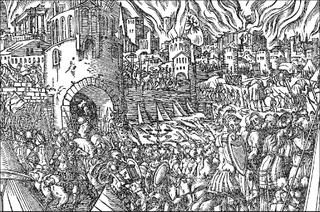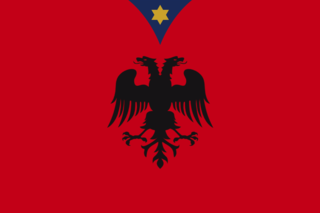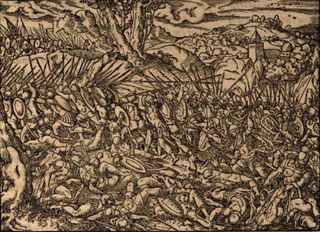Ottoman Albania refers to a period in Albanian history from the Ottoman conquest in the late 15th century to the Albanian declaration of Independence and official secession from the Ottoman Empire in 1912. The Ottomans first entered Albania in 1385 upon the invitation of the Albanian noble Karl Thopia to suppress the forces of the noble Balša II during the battle of Savra. They had some previous influence in some Albanian regions after the battle of Savra in 1385 but not direct control. The Ottomans placed garrisons throughout southern Albania by 1420s and established formal jurisdiction in central Albania by 1431. Even though The Ottomans claimed rule of all Albanian lands, most Albanian ethnic territories were still governed by medieval Albanian nobility who were free of Ottoman rule. The Sanjak of Albania was established in 1420 or 1430 controlling mostly central Albania, while Ottoman rule became more consolidated in 1481, after the fall of Shkodra and League of Lezhe with the country being mostly free in the period of 1443–1481. Albanians revolted again in 1481 but the Ottomans finally controlled Albania by 1488.

The League of Lezhë was a military and diplomatic alliance of the Albanian aristocracy, created in the city of Lezhë on 2 March 1444. The League of Lezhë is considered the first unified independent Albanian country in the Medieval age, with Skanderbeg as leader of the regional Albanian chieftains and nobles united against the Ottoman Empire. Skanderbeg was proclaimed "Chief of the League of the Albanian People," while Skanderbeg always signed himself as "DominusAlbaniae".

The Battle of Albulena, also known as the Battle of Ujëbardha, was fought on 2 September 1457 between Albanian forces led by Skanderbeg and an Ottoman army under Isak bey Evrenoz and Skanderbeg's nephew, Hamza Kastrioti.

The first siege of Krujë occurred in 1450 when an Ottoman army of 100,000 led by Sultan Murad II and his crown prince Mehmed II tried to besiege the Albanian town of Krujë. The League of Lezhë, led by Skanderbeg, experienced low morale after losing Svetigrad and Berat between 1448 and 1450. Nevertheless, Skanderbeg's exhortations and the support of the clergy, who claimed to have had visions of angels and victory, motivated the Albanians to defend the capital of the League, Krujë, at all costs. After leaving a protective garrison of 4,000 men under his trusted lieutenant Vrana Konti, Skanderbeg harassed the Ottoman camps around Krujë and attacked the supply caravans of Sultan Murad II's army. By September, the Ottoman camp was in disarray as morale sank and disease ran rampant. The Ottoman army acknowledged that the castle of Krujë would not fall by strength of arms, lifted the siege, and made its way to Edirne. Soon thereafter, in the winter of 1450–51, Murad died in Edirne and was succeeded by his son, Mehmed II.

The second siege of Krujë took place from 1466 to 1467. Sultan Mehmed II of the Ottoman Empire led an army into Albania to defeat Skanderbeg, the leader of the League of Lezhë, which was created in 1444 after he began his war against the Ottomans. During the almost year-long siege, Skanderbeg's main fortress, Krujë, withstood the siege while Skanderbeg roamed Albania to gather forces and facilitate the flight of refugees from the civilian areas that were attacked by the Ottomans. Krujë managed to withstand the siege put on it by Ballaban Badera, sanjakbey of the Sanjak of Ohrid, an Albanian brought up in the Ottoman army through the devşirme. By 23 April 1467, the Ottoman army had been defeated and Skanderbeg entered Krujë.

Gjergj Kastrioti, commonly known as Skanderbeg, was an Albanian feudal lord and military commander who led a rebellion against the Ottoman Empire in what is today Albania, North Macedonia, Greece, Kosovo, Montenegro, and Serbia.

The Principality of Kastrioti was one of the Albanian principalities during the Late Middle Ages. It was formed by Pal Kastrioti who ruled it until 1407, after which his son, Gjon Kastrioti ruled until his death in 1437 and then ruled by the national hero of Albania, Skanderbeg.

The Second Battle of Oranik took place during the spring of 1456 in the plains of Oranik. Moisi Arianit Golemi, lord of Debar, and one of Skanderbeg's officers, deserted to the Ottomans following the defeat at Berat in 1455. Golemi set off from Adrianople with an army to capture Albania but was swiftly defeated by Skanderbeg's smaller forces.
The Battle of Mokra took place on October 10, 1445 near mountain Mokra. It was an Ottoman retaliation to a message sent by Skanderbeg to Murad II. The Albanian forces under Skanderbeg defeated the Ottoman forces under Firuz Pasha. It was the second major Albanian victory over the Ottoman Empire.
The Battle of Otonetë occurred on September 27, 1446, in upper Dibra in Albania. The Ottoman commander, Mustafa Pasha, was sent into Albania, but was soon intercepted and defeated by Skanderbeg. It was one of the many victories won by Skanderbeg.
The First Battle of Oranik took place during the Albanian-Venetian War of 1447-1448, when the Republic of Venice allied with the Ottoman Empire against the League of Lezhë. The Albanian forces under Skanderbeg defeated the Ottoman army led by Mustafa Pasha during a battle that took place near Oranik of Upper Dibra, and two months later, peace was established between Albania and Venice.

The siege of Svetigrad or Sfetigrad began on 14 May 1448 when an Ottoman army, led by Sultan Murad II, besieged the fortress of Svetigrad. After the many failed Ottoman expeditions into Albania against the League of Lezhë, a confederation of Albanian Principalities created in 1444 and headed by Skanderbeg, Murad II decided to march an army into Skanderbeg's dominions in order to capture the key Albanian fortress of Svetigrad. The fortress lay on an important route between present-day North Macedonia and Albania, and thus its occupation would give the Ottomans easy access into Albania.

Skanderbeg's Italian expedition (1460–1462) was undertaken to aid his ally Ferdinand I of Naples, whose rulership was threatened by the Angevin Dynasty. Gjergj Kastrioti Skanderbeg was the ruler of Albania who had been leading a rebellion against the Ottoman Empire since 1443 and allied himself with several European monarchs in order to consolidate his domains. In 1458, Alfonso V of Aragon, ruler of Sicily and Naples and Skanderbeg's most important ally, died, leaving his illegitimate son, Ferdinand, on the Neapolitan throne; René d'Anjou, the French Duke of Anjou, laid claim to the throne. The conflict between René's and Ferdinand's supporters soon erupted into a civil war. Pope Calixtus III, of Spanish background himself, could do little to secure Ferdinand, so he turned to Skanderbeg for aid.

The Battle of Polog was the result of an Albanian incursion into Ottoman territory. Aided by Alfonso the Magnanimous, the Albanian leader Skanderbeg made plans to recapture Svetigrad, which had been lost in 1448. His strategy involved launching an invasion of Macedonia to devastate the country surrounding Svetigrad and to lure the garrison into a trap. While implementing this, he was stopped in the fields of Polog near Tetovo by a force which was planning to invade Albania led by his old friend Ibrahim Pasha. The force was quickly destroyed and Skanderbeg's army proceeded its looting before returning to Debar.

Vrana, historically known as Vrana Konti was an Albanian military leader who was distinguished in the Albanian-Turkish Wars as one of the commanders of Gjergj Kastrioti Skanderbeg, of whom he was one of the closest councillors. He probably belonged to the class of small lords who were tied to the Kastrioti family and possibly belonged to a common lineage (fis) with them. In his youth, he fought as a mercenary in the armies of Alfonso the Magnanimous. The term conte ("count") with which he became known in historical accounts didn't refer to an actual title he held, but to his status as a figure of importance.
Skanderbeg's Macedonian campaign was a preemptive campaign into the Ottoman Empire in Macedonia by Skanderbeg to defeat three Ottoman armies which had been prepared for the joint-invasion of Albania. From 1461 to 1462, Skanderbeg campaigned in Italy to protect his ally, Ferdinand I, from being overrun by the Angevin dynasty which claimed the Kingdom of Naples. Before setting out for Italy, Skanderbeg forged a truce with Sultan Mehmed II. Upon returning to Albania after securing Ferdinand, the Venetians became hostile to Skanderbeg and a sort of undeclared war took place. Mehmed saw an opportunity to attack Skanderbeg and sent three armies in one year. All three were defeated by Skanderbeg, however, in August 1462.
On August 1465, Ballaban Badera, a sanjakbey of the Sanjak of Ohrid who was an Albanian-born janissary launched his fourth but largest campaign against Skanderbeg. He was defeated in both battles of Ohrid and Vajkal the year before. Ballaban had previously inflicted severe casualties on Skanderbeg's forces and soon received high favor from Mehmet II. He soon appointed Ballaban and Jakup Arnauti—both Albanian peasants by birth—to lead a joint-campaign against Skanderbeg's forces. According to some scholars, this act of inclusion by the Sultan was a promotion of a social revolution within Albania to wean forces away from Skanderbeg.
The Ottoman invasion of Albania in 1452 was a campaign by the newly acceded Ottoman sultan Mehmed II against Skanderbeg, the chief of the League of Lezhë. Shortly after the first siege of Krujë, Murad II died in Edirne, and was succeeded by his son Mehmed II. Mehmed ordered nearly annual invasions of Albania which often resulted in multiple battles in one year. The first of these expeditions was sent in 1452 under the dual command of Hamza Pasha and Tahip Pasha, with an army of approximately 25,000 men.

The Battle of Ohrid took place on 14 or 15 September 1464 between Albanian ruler Skanderbeg's forces and Ottoman forces. A crusade against Sultan Mehmed II had been planned by Pope Pius II with Skanderbeg as one of its main leaders. The battle near Ohrid occurred as a result of an Albanian incursion into Ottoman territory. The Ottomans stationed in the area were assaulted by Skanderbeg's men and 1,000 Venetian soldiers under Cimarosto. The Ottomans were lured out of their protections in Ohrid and ambushed by the Albanian cavalry. Skanderbeg won the resulting battle and his men earned 40,000 ducats after captured Ottoman officers were ransomed. Pius II died before the planned crusade began, however, forcing Skanderbeg to fight his battles virtually alone.

The Albanian-Ottoman Wars (1432–1479) were a series of wars and revolts against the rising Ottoman Empire by Albanian feudal lords. The wars and revolts took place in present-day Albania, Montenegro, Kosovo, North Macedonia and South Serbia. In this period, Albanians under the leadership of Gjergj Arianiti and especially later under Skanderbeg resisted the Ottomans under two Sultans in over 30 battles. Skanderbeg continued this resistance until his death in 1468, and the Albanians persevered for another 11 years before being defeated.












